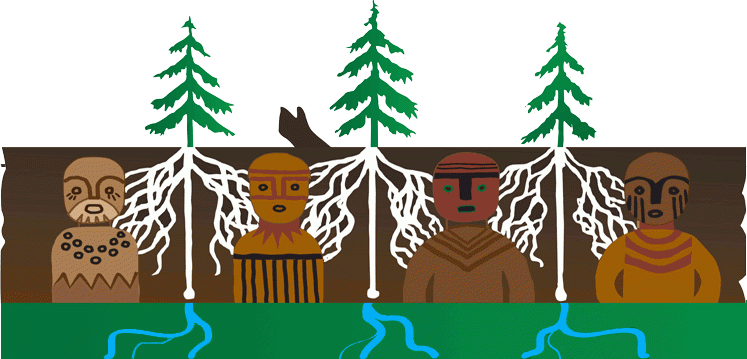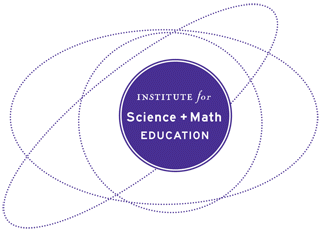Brief 03 - Indigenous Child Development
Written By Ananda MarinCentral to development are questions of self-concept, identity and possible selves (1). Identity development has received limited attention in research on early childhood education and cognitive development (2). Nationally, the conversation about child development has focused on school related achievement. Increasing academic performance and school readiness among young children from non-dominant and low-income communities is a concern for many researchers (3). While increasing academic achievement among Indigenous youth is important, the conversation around schooling and testing should not direct our attention away from other concerns that are equally important. There is a real need to develop early education programs that are community-based and grounded in theories of development and methodologies that arise from Indigenous knowledge systems.
Human development is a dynamic and relational process of becoming and being over the life course and is supported by education across contexts. It also involves recognizing and caring for our gifts in order to skillfully contribute to the communities to which we belong in ways where we feel competent and productive.
ENROLLMENT RATES in WA Public Schools for American Indian, Alaska Native, Pacific Islander, and Native Hawai’ian
|
10,099 |
16,417 |
1,919 |
| # Pacific Islander Students Enrolled In Washington Public Schools 2013-2014 (4) | # American Indian/ Alaskan Native In Wa Public Schools ‘13-’14 (4) |
# Aisian & Pacific Islander/ Native Hawai’ians In State Kindergarten ‘14-’15 (5) |
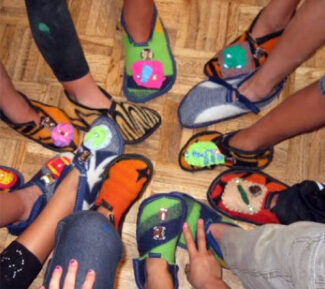
Critical Reflection And Questions
Development is transactional and includes multiple pathways6. Interactions shape our identities and our identities shape our interactions and participation in activities (7).
- What narratives do young Indigenous children encounter about possible selves?
- What kinds of learning ecologies support the development of Indigenous identities?
- What supports do teachers’ need so that they can better understand parents’ and young children’s cultural ways of knowing and doing?
- What structures need to be in place so that teachers and schools can gain a more nuanced understanding of cultural pathways for development?
- What structures need to be in place so that teachers and schools can effectively collaborate with families and tribes in order to design learning spaces that support cultural ways of doing and knowing?
Indigenous Identity Development
There is a small but growing body of research on Indigenous identity and development among young children (8). Recently, scholars have worked to document existing knowledge about trends across research studies on Indigenous child development (2). Researchers have found that young American Indian and Alaska Native children (AI/AN) fall below national norms across various domains.
It is important to remember that research findings, such as those to the below are nested within particular contexts. For many Indigenous communities, traditional methods of education and child rearing have been altered by “a long history of government policies designed to disrupt tribal lands, cultural practices, language and family relationships” (8, p. 43.).
→ In one study, when tested with standardized assessments for visual reception, fine motor, and gross motor skills, AI children fell below the national norm at the age of 15 months and their performance in these areas did not significantly increase by 36 months. This finding is of particular concern because of the impact disparities in these areas may have for cognitive development and performance in school (9).
→ Studies have found a strong relationship between a mother’s behavior and child’s internalizing and externalizing behavior10-11. While research has identified disparities in health, development and academic achievement, there has also been a turn to investigate competencies and community-based models for development and intervention (8).
→ Children who were perceived by their teachers as exhibiting positive approaches to learning also had higher baseline scores in reading and math (12).
→ A positive relationship has also been found between a mother’s American Indian identity and a child’s socio-emotional competence (10).
Marks & Garcia Coll note that the findings about teacher perceptions have important implications for both childrearing practices and schooling practices (12). The cognitive skills necessary for success in schooling may not map onto the skills that are promoted during the early developmental years within Indigenous communities. This means that the transition to school may be especially difficult for Indigenous children and present additional developmental demands. Additionally, programs and interventions designed to support a mother’s participation in cultural practices may facilitate development growth.
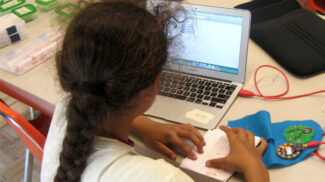
Areas For Future Research
Increasingly, Indigenous scholars are raising questions about development and socialization in regard to cultural survivance, cultural revitalization and educational self-determination (8, 13-14). Findings from research on AI/AN child development raises important questions about the transactional nature of development, as well as the role of identity and experience in cognitive development. Emerging areas for research in the field include:
→ The examination of assessments and measures from a cultural lens. This includes working with tribal communities to determine the cultural appropriateness of measures (10).
→ Engaging in descriptive research of families’ everyday practices (15) and socialization processes (2). Research in this area, may help us to identify more nuanced measures for American Indian identity and develop culturally-based programming.
→ Assessing teachers’ perceptions of AI/AN student’s classroom behavior and their views on culture and development.
→ The iterative design and evaluation of programs, interventions and pedagogical supports.
As we continue to understand the cultural nature of cognitive, social, and emotional development, a crucial step in translating research to educational settings will require creative and multidisciplinary collaborations. Utilizing tribal methodologies (15) and engaging parents and tribal communities, at the both the curricular design and implementation stages, will not only support the healthy development of Indigenous children, but the healthy development of teachers and schools as well (2).
Things To Consider
→ Many of the standardized instruments that are used to study development are not culturally neutral and are often designed to measure skills that are important for performance in activities related to school readiness rather than the activities or that families and tribes hold as vital and life-sustaining (9, 16.).
"Cultural Metaphors" For Education
Metaphors or frameworks for education impact the organization of schooling and opportunities for learning, as well as models of development16. Indigenous scholars have called attention to differences in Western versus Tribal education. For example, unlike Western education, Tribal education has tended to focus on relationships, particularly, inter-relationships between humans and nature (17-18). Each viewpoint impacts the socialization process and has cognitive, as well as academic, consequences.
Cross-cultural work in folk biology demonstrates the importance of experience and cultural frameworks (i.e., what is worthy of attention and explanation), for understanding biological and physical processes in the natural world (19).
For example, in an analysis of interview data from a reasoning task where young children where asked to generalize about properties from one kind of animal to another, Bang, Medin,& Atran report that Menominee children, unlike their rural European American counterparts were less likely to say that “people are not animals” (20, p. 13869).
This work raises key questions about:
→ How young children are socialized to view themselves in relation to other kinds and the natural world (e.g., a part of or a part from)
→ How research can inform instructional design and early science learning programs
In work with colleagues from the Menominee Nation and the American Indian Center (21) in Chicago, IL, we engaged community members in designing and building “ culturally sustaining/ revitalizing pedagogy” (13). It meant developing culturally appropriate strategies for pedagogy, building and maintaining relationships, and a firm understanding of learning processes.
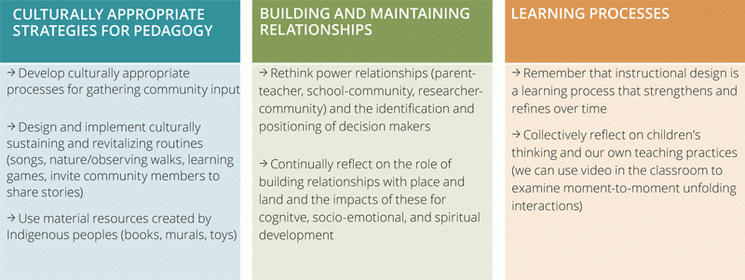
References
1. Oyserman D, Fryberg S. The possible selves of diverse adolescents: Content and function across gender, race and national origin. In Dunkel C, Kerpelman J, editors, Possible selves: Theory, research, and applications. Nova Science Publishers; 2006: 17-39.
2. Spicer P, LaFramboise T, Markstrom C, Niles M, West A, Fehringer, K,... & Sarche M. Toward an applied developmental science for Native children, families, and communities. Child Dev. Perspect. 2012: 6(1): 49-54.
3. Howes C, Burchinal M, Pianta R, Bryant D, Early D, Clifford R, Barbarin O. Ready to learn? Children's pre-academic achievement in pre-kindergarten programs. Early Child. Res. Quart. 2008; 23(1): 27-50.
4. Office of the Superintendent of Public Instruction Washington State Report Card.
5. Washington Inventory of Developing Skills. Jan 2013. Fall 2013 WaKIDS Data Summary.
6. Galliher RV, Tsethlikai MM, Stolle D. Perspectives of Native and nonNative scholars: Opportunities for collaboration. Child Dev. Persp. 2012; 6(1): 66-74.
7. Tucker-Raymond E, Varelas M, Pappas CC, Korzh A, Wentland A. "They probably aren't named Rachel": Young children's scientist identities as emergent multimodal narratives. Cult. Stud. Sci. Educ. 2007; 1(3): 559-592.
8. Sarche MC, Whitesell NR. Child development research in North American Native communities--looking back and moving forward: Introduction. Child Dev. Persp. 2012; 6(1): 42-48.
9. Mitchell CM, Croy C, Spicer P, Frankel K, Emde RN. Trajectories of cognitive development among American Indian young children. Dev. Psychol. 2011; 47(4); 991.
10. Frankel KA, Croy CD, Kubice LF, Emde RN, Mitchell CM, Spicer P. Toddler socioemotional behavior in a Northern Plains Indian tribe: Associations with maternal psychological well-being. Inf. Ment. Health H. 2014; 35(1): 10-20.
11. Sarche MC, Croy CD, Crow CB, Mitchell CM, Spicer P. Maternal correlates of 2-year-old American Indian children's social-emotional development in a Northern Plains tribe. Inf. Ment. Health J. 2009; 30(4): 321-340.
12. Marks AK, Coll CG. Psychological and demographic correlates of early academic skill development among American Indian and Alaska Native youth: A growth modeling study. Dev. Psychol. 2007; 43(3): 663.
13. McCarty TL, Lee TS. Critical culturally sustaining/revitalizing pedagogy and Indigenous education sovereignty. Harvard Educ. Rev. 2014; 84(1): 101-124.
14. Yazzie-Mintz T. Native teachers' beliefs and practices: Choosing language and cultural revitalization over uniformity and standardization, Contemp. Issues Early Child. 2011; 12(4): 315-326.
15. Allen, J, Mohatt GV, Markstrom CA, Byers L, Novins DK. "Oh no, we are just getting to know you": The relationship in research with children and youth in Indigenous communities. Child Dev. Persp. 2012; 6(1): 55-60.
16. Cajete G, Pueblo SC. Contemporary Indigenous education: A nature-centered American Indian philosophy for a 21st century world. Futures. 2010; 42(10): 1126-1132.
17 Archibald J. Indigenous Storywork. Vancouver (BC): UBC Press; 2008.
18. Cajete G. American Indian epistemologies. New Directions for Student Services. 2005; 109(109): 69-78.
19. Medin D, Ojalehto B, Marin M, Bang M. Culture and epistemologies: Putting culture back into the ecosystem. In Gelfand M, Chiu CY, Hong Y-Y, editors Advances in Culture and Psychology. Oxford University Press; 2013: pp. 177-217.
20. Bang M, Medin DL, Atran S. Cultural mosaics and mental models of nature. Proc. Nat. Acad. Sci. 2007; 104(35): 13868-13874.
21. Medin DL, Bang M. Culture in the classroom. Phi Delta Kappan. 2013; 95(4): 64-67.
22. Dubosarsky M, Murphy B, Roehrig G, Frost LC, Jones J, Carlson SP. "Animosh" tracks on the playground, minnows in the sensory table: Incorporating cultural themes to promote preschoolers' critical thinking in American Indian Head Start classrooms. Young Child. 2011; 66(5): 20-29.
23. Romero-Little ME. How should young Indigenous children be prepared for learning? A vision of early childhood education for Indigenous children. J. Amer, Ind. Educ. 2010; 49(1 & 2): 7-27.
Images curtesy of EMMAS Project: Native Science, Technology, Engineering, Art, and Math Summer Program
FOR MORE INFORMATION:
- IET Brief #1 Culture and Learning
- IET Brief #2 Indigenous Evaluation
- IET Brief #4 Seeing Students’ Learning
- Wakanyaja “Sacred Little Ones” Early Childhood EducationInitiative”22
- “Becoming Jemez: The Early Childhood of Jemez Children”23
- STEM Teaching Tools Project Site
CONNECT WITH US ON SOCIAL MEDIA
- Facebook- Indigenous Education Tools
- Twitter- @indedtools; #indigenousevaluation; #nativeed; #ourstoryourplace
Indigenous Education Tools is a part of the Building Capacity And Cultivating Innovation project (BCCI). BCCI is designed to develop resources and practices that will have exponential impacts on efforts to improve Native student success across a variety of sectors.
Indigenous Education Tools / BCCI Project Contacts:
Megan Bang- mbang3@uw.edu
Charlene Nolan- nolanc3@uw.edu
Gabriel de Los Angeles- kender20@uw.edu
